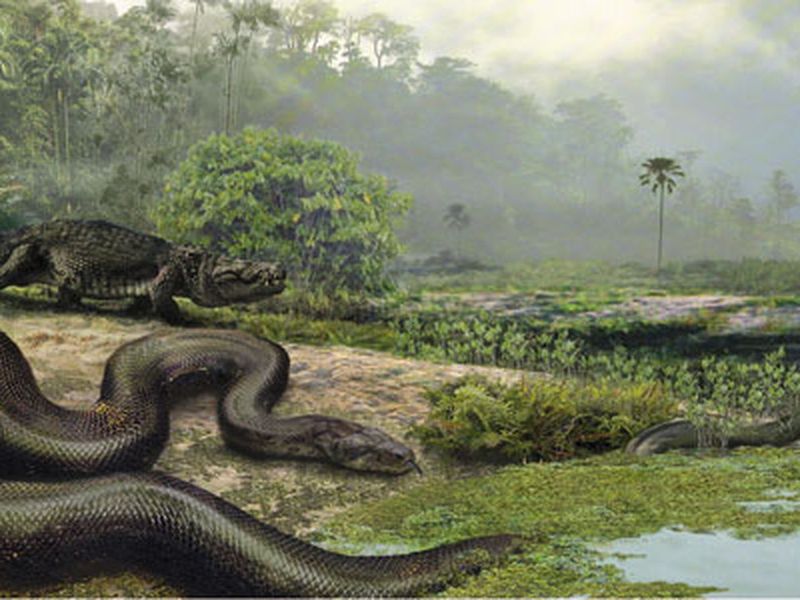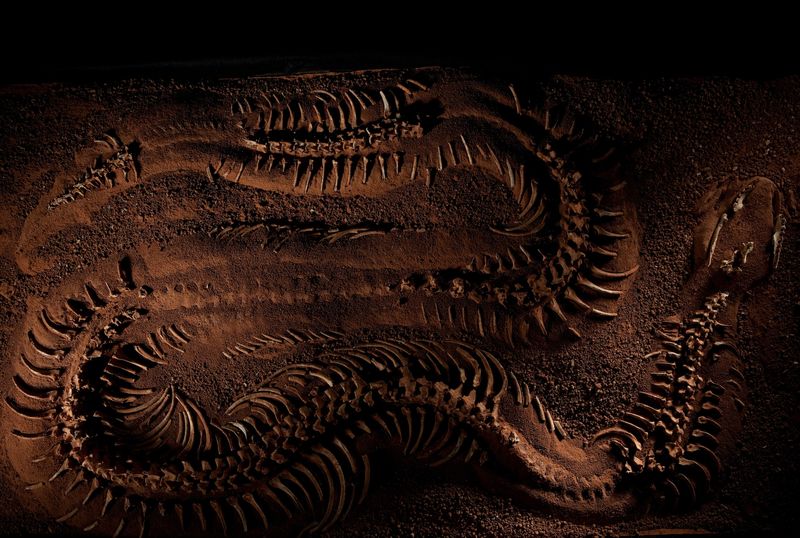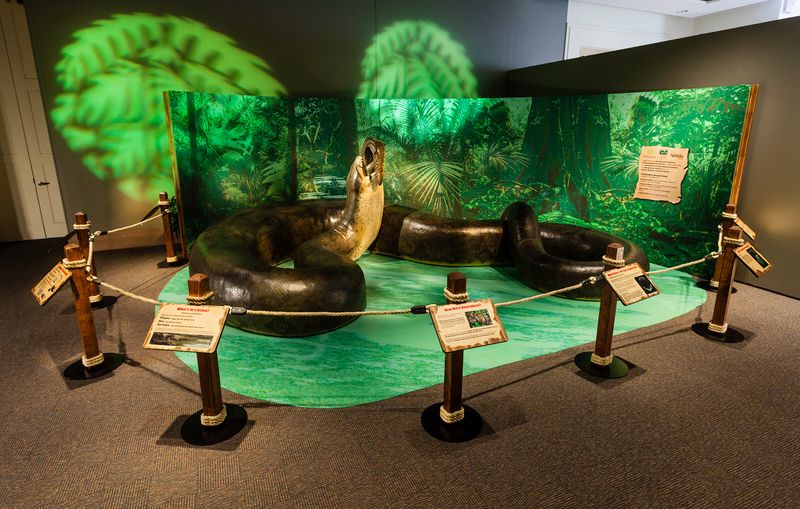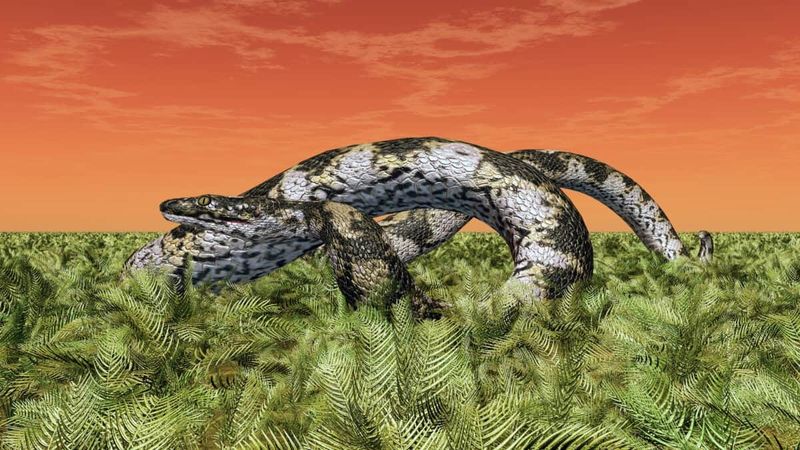Once upon a time, the king of the jungle… slithered.
Forget lions and dinosaurs. Titanoboa was the ultimate nightmare—stretching over 40 feet long and weighing more than a ton. This snake didn’t just survive in prehistoric swamps. It ruled them.
Its body was thick as an oil drum. Its coils could crush crocodiles like empty soda cans. And when it moved, the ground may as well have trembled.
This wasn’t just a snake—it was a prehistoric horror show, alive and hungry. Ready to meet the beast that made T. rex look over its shoulder? Let’s do this.
Titanoboa’s Impressive Size

Imagine spotting a snake that’s as long as a school bus! Titanoboa, the largest snake ever discovered, could reach up to 40 feet in length and weighed around 2,500 pounds. Its sheer size made it the top predator in its ecosystem, capable of overpowering anything in its vicinity. Hailing from the sweltering jungles of ancient Colombia, Titanoboa thrived in the hot and humid climate that fostered its gigantic growth. Such enormous proportions are rarely seen today, and just picturing it sends a chill down one’s spine. What a sight it must have been!
The Swampy Habitat

Picture a world teeming with dense jungles and swampy waters—that was Titanoboa’s domain. Residing in what is now modern-day Colombia, this gigantic snake slithered through ancient swamps, hunting its prey with stealth and precision. The lush vegetation of these swamps provided ample cover, aiding its ambush hunting technique. This habitat was warm and tropical, ideal for cold-blooded creatures like Titanoboa. Today, the fossils unearthed from these regions offer a glimpse into the rich biodiversity that thrived alongside this colossal serpent. The swamps were a paradise for Titanoboa, the true king of this prehistoric jungle.
Diet of a Giant

Titanoboa had an appetite as grand as its size! Its diet primarily consisted of large prey such as crocodiles and giant fish. With its powerful constriction abilities, it could easily overpower these formidable creatures. The Titanoboa’s jaw was capable of opening wide enough to swallow its prey whole, a remarkable feat of nature’s engineering. Fossil evidence reveals that its hunting prowess was unmatched, making it the apex predator of its time. For those creatures unfortunate enough to cross its path, escape was hardly an option. It’s a fascinating glimpse into the power dynamics of prehistoric ecosystems.
The Fossil Discovery

In 2009, an incredible discovery was made in a Colombian coal mine: the fossils of the Titanoboa. These well-preserved remains offered scientists a window into the distant past, revealing the massive scale of this prehistoric snake. Carefully excavated by paleontologists, these fossils provided crucial insights into the Titanoboa’s physical characteristics, ecosystem, and lifestyle. The discovery of its vertebrae allowed researchers to accurately estimate its astonishing length. These findings have since captivated the scientific community and the public alike, highlighting the wonders that still lie hidden in the earth’s ancient layers.
Reconstruction of a Giant

The reconstruction of Titanoboa has brought this prehistoric giant back to life—at least in part. Museums around the world now showcase life-sized models of the snake, allowing visitors to fully grasp its impressive size. These reconstructions are based on detailed analysis of fossil evidence and offer a tangible connection to our planet’s distant past. Standing next to one of these models is a humbling experience, emphasizing the Titanoboa’s dominance in its environment. These exhibits not only educate but also inspire awe, reminding us of the incredible diversity of life that once roamed the earth.
An Apex Predator

Titanoboa was the apex predator of its time, ruling the prehistoric swamps with an iron grip. Its massive size and strength allowed it to take down virtually any creature it encountered. With no natural predators, it sat at the top of the food chain, dictating the balance of life in its ecosystem. The Titanoboa’s presence would have been a terrifying sight to any animal that crossed its path. This dominance was key to its survival, ensuring its reign over the swamps for millions of years. The legacy of this giant predator continues to fascinate and terrify in equal measure.
Titanoboa’s Warm Climate

The warm, humid climate of prehistoric Colombia was crucial for the Titanoboa’s existence. Its large size was made possible by the higher global temperatures, which supported cold-blooded animals like reptiles. This climate allowed for the flourishing of dense jungles and swamps, rich with the biodiversity that sustained such a massive predator. Titanoboa thrived in this perfect environment, growing larger than any snake known today. Understanding this climate gives us insight into how ancient ecosystems functioned and how temperature influenced the evolution of species like Titanoboa. The snake’s story is a testament to nature’s adaptability and resilience.
Comparing to Modern Snakes

Titanoboa makes even the largest modern snakes seem diminutive in comparison. While today’s biggest snakes, like the green anaconda or reticulated python, can reach impressive lengths, they pale next to Titanoboa’s 40-foot stretch. This prehistoric giant was not only longer but also considerably bulkier, with a girth that could easily surpass any snake seen today. The comparison highlights just how unique and extraordinary Titanoboa was, offering a fascinating perspective on the evolutionary pathways that have produced the reptiles we know today. Its existence challenges our understanding of size and scale in the animal kingdom.
Ancient Ecosystem Dynamics

The ecosystem in which Titanoboa lived was a complex web of life, teeming with diverse flora and fauna. Its presence had a significant impact on the balance of this ecosystem, acting as a regulator of prey populations. This balance ensured the thriving of a myriad of species, each playing a role in this prehistoric world. The Titanoboa not only shaped its environment through predation but also through competition with other predators. Its dominance contributed to the dynamic interactions that fueled the diversity and richness of life during that era. This glimpse into the past offers valuable insights into ecological relationships.
Mysteries of Titanoboa’s Extinction

The extinction of Titanoboa remains a tantalizing mystery. As the climate cooled, the warm conditions that supported its massive size began to disappear. This change likely led to a decline in suitable habitats and prey, contributing to its eventual extinction. Some theories suggest that competition with smaller, more adaptable reptiles also played a role. While the exact reasons remain uncertain, the disappearance of Titanoboa marked the end of an era in the prehistoric swamps. Its extinction highlights the delicate balance of ecosystems and the impact of environmental change on species survival.
The Legacy of Titanoboa

The legacy of Titanoboa extends far beyond its impressive size. Its discovery has provided invaluable insights into prehistoric life and the evolutionary history of reptiles. By studying Titanoboa, scientists have gained a better understanding of how ancient ecosystems functioned and how climate change influenced the development of life on Earth. The snake’s fossil remains continue to captivate researchers, driving further exploration and discovery. Titanoboa’s story is a reminder of nature’s incredible potential for diversity and adaptation, inspiring scientific curiosity and admiration for the planet’s rich history of life.
Titanoboa in Popular Culture

Titanoboa’s awe-inspiring size and mysterious nature have made it a popular figure in media and entertainment. Often portrayed as a monstrous creature in films and documentaries, it captures the imagination of audiences worldwide. Whether featured in blockbuster movies or educational programs, Titanoboa is depicted as a symbol of prehistoric power and mystery. Its fascinating story continues to intrigue and entertain, bridging the gap between science and popular culture. The snake’s presence in media serves to spark curiosity and fascination, drawing attention to the wonders of ancient life and the untold stories of the past.
The Scientific Debate

Titanoboa has been at the center of scientific debate since its discovery. Discussions range from its growth patterns to its hunting strategies and ecological impact. New fossil evidence continuously fuels these debates, as researchers strive to piece together the puzzle of Titanoboa’s life. This scientific discourse reflects the dynamic nature of paleontology, where each discovery adds layers of complexity to our understanding. The debates surrounding Titanoboa highlight the challenges and excitement of studying the past, where every fossil has the potential to rewrite the history of life on Earth. It’s a vibrant field that thrives on curiosity and discovery.

